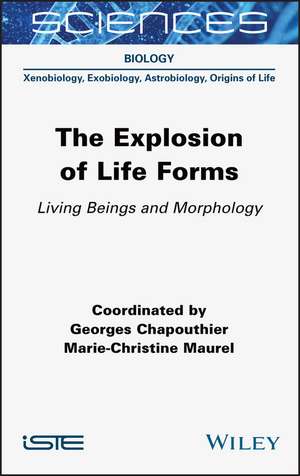The Explosion of Life Forms – Living Beings and Morphology
Autor G Chapouthieren Limba Engleză Hardback – 6 mai 2021
Preț: 981.34 lei
Preț vechi: 1078.39 lei
-9% Nou
Puncte Express: 1472
Preț estimativ în valută:
187.80€ • 194.01$ • 156.30£
187.80€ • 194.01$ • 156.30£
Carte tipărită la comandă
Livrare economică 25 martie-08 aprilie
Preluare comenzi: 021 569.72.76
Specificații
ISBN-13: 9781789450057
ISBN-10: 1789450055
Pagini: 256
Dimensiuni: 173 x 249 x 20 mm
Greutate: 0.54 kg
Editura: ISTE Ltd.
Locul publicării:Hoboken, United States
ISBN-10: 1789450055
Pagini: 256
Dimensiuni: 173 x 249 x 20 mm
Greutate: 0.54 kg
Editura: ISTE Ltd.
Locul publicării:Hoboken, United States
Cuprins
Introduction xi
Georges CHAPOUTHIER and Marie-Christine MAUREL
Chapter 1. Possible Traces and Clues of Early Life Forms 1
Marie-Christine MAUREL
1.1. Introduction 1
1.2. Have "things" always been as they are today? 2
1.3. Fossil traces? 4
1.4. Geochemical elements confirming these recent results 6
1.5. Compartmentalization of resources and primary biomass 9
1.6. Rebuilding a living cell: a wide range of possibilities explored, from the mineral to the organic 12
1.7. Conclusion 13
1.8. Acknowledgments 14
1.9. References 14
Chapter 2. The Nature of Life 19
Andreas LOSCH
2.1. Observations and assumptions 20
2.2. Descriptions and definitions 21
2.3. Exploration 23
2.4. Conclusion 25
2.5. References 26
Chapter 3. From Form to Function 29
Jean-Pierre GASC
3.1. Form: a concept for knowledge 29
3.2. Basic structural elements: from the molecule to the cell 31
3.3. The weight of the physical setting 34
3.4. Mesoderm: base material for architect genes 35
3.5. Appendices and laws of mechanics 37
3.6. "Appendicular" movement on land 40
3.7. The legless 44
3.8. And the head 44
3.9. References 47
Chapter 4. On Growth and Form: Context and Purpose 51
Jean-Pierre GASC
4.1. D'Arcy Thompson's program 54
4.2. Application of mathematics to morphometry 59
4.3. References 61
Chapter 5. The Emergence of Form in the History of Epigenetics 65
Jonathan B. WEITZMAN
5.1. Introduction 65
5.2. From epigenesis to epigenetics 66
5.3. The evolution of the epigenetic landscape 68
5.4. Modernizing the epigenetic landscape 70
5.5. From epigenetic landscape to chromosome conformation 72
5.6. Conclusion: from form to function 75
5.7. Acknowledgments 76
5.8. References 76
Chapter 6. The Many Shapes of Microbial Detection of Kin and Kind 79
Guillermo PAZ-Y-MIÑO-C and Avelina ESPINOSA
6.1. From Darwin's social-insects-puzzle to microbes 80
6.2. Handshakes of kinship or "kindship" in bacteria 81
6.3. The ameba world of clone discrimination/recognition 85
6.4. Social microbes and multicellularity 88
6.5. Conclusion 95
6.6. References 95
Chapter 7. Development and Evolution of Plant Forms 101
Florian JABBOUR and Guilhem MANSION
7.1. Introduction 101
7.2. Diversity of plant forms and associated functions 102
7.2.1. Anthropocentric view of plant forms 102
7.2.2. Plant forms perceived by pollinators 103
7.3. Origin and evolution of plant forms 104
7.3.1. Pattern formation during ontogenesis 104
7.3.2. Physical-mathematical considerations on plant morphogenesis 105
7.3.3. Implementation of forms during phylogenesis 107
7.4. Origin and evolution of plant forms 112
7.4.1. Usefulness for human societies 112
7.4.2. Usefulness for botanical classifiers 114
7.5. Conclusion 118
7.6. Acknowledgements 118
7.7. References 118
Chapter 8. Forms of Memory 125
Robert JAFFARD
8.1. Introduction 125
8.2. The polymorphism of memory 126
8.3. Non-associative memories 127
8.3.1. Habituation and sensitization 127
8.3.2. Priming 129
8.3.3. Perceptual learning 130
8.4. Classical conditioning 131
8.4.1. Operational definition, rules and varieties of classical conditioning 131
8.4.2. Contemporary theory of classical conditioning 132
8.4.3. The importance of classical conditioning 133
8.5. Instrumental conditioning 134
8.5.1. Law of effect, stimulus-response (S-R) theory and "habits" 134
8.5.2. From S-R theory to cognitive theories 135
8.5.3. The two facets of instrumental conditioning 136
8.6. Procedural memory as a "memory system" 137
8.6.1. Habits: double functional dissociations in mammals 137
8.6.2. Human procedural memory and its cerebral supports 139
8.7. Declarative memory 140
8.7.1. Episodic and semantic memory: definitions, properties and relationships 141
8.7.2. Episodic memory in animals? 143
8.8. Short-term memory and working memory 144
8.8.1. General characteristics 144
8.8.2. Models 144
8.8.3. Short-term memory in animals 146
8.8.4. Cerebral substrates 147
8.9. Conclusion: organization and reconfiguration of the different forms of memory 147
8.10. References 150
Chapter 9. The Construction of Sensory Universes 155
Dalila BOVET
9.1. Introduction 155
9.2. Chemoreception 156
9.2.1. Taste 156
9.2.2. Smell 158
9.3. Mechanoreception 159
9.3.1. Touch 160
9.3.2. Lateral lines 160
9.3.3. Hearing 161
9.4. Electromagnetoreception 163
9.4.1. Vision 163
9.4.2. Electroreception 165
9.4.3. Magnetoreception 166
9.4.4. Thermoreception 167
9.5. Information filtering 167
9.6. Conclusion 170
9.7. References 172
Chapter 10. Emotional and Social Forms of Robots 173
Laurence DEVILLERS
10.1. Introduction 173
10.2. Communication with social and emotional robots 175
10.3. Human empathy for machines 176
10.4. Machine emotions 178
10.5. Conclusion: risks and benefits 180
10.6. References 181
Chapter 11. When Medical Technology Mimics Living Forms 183
Didier FASS
11.1. Introduction 183
11.2. Historical and epistemological perspective 184
11.2.1. A comparative history of medical technology 184
11.2.2. Epistemological perspective 189
11.2.3. A conceptual and theoretical framework: the mathematical theory of integrative physiology (MTIP) by Gilbert Chauvet 193
11.2.4. Forms of thinking or processing by machines 196
11.3. Simulation, biomimetics and bioprinting: a future for medical technology 196
11.4. References 199
Chapter 12. From Living to Thinking: Mosaic Architecture 203
Georges CHAPOUTHIER
12.1. Introduction 203
12.2. Two main principles 203
12.3. Genes and cells 204
12.4. More complex anatomical mosaics 206
12.5. Epistemological rehabilitation of asexual reproduction 207
12.6. Social mosaics 208
12.7. Encephalic mosaics 208
12.8. Mosaics of thought 210
12.9. Man-made objects 213
12.10. Human and animal cultural traits 214
12.11. A universality of mosaics? 215
12.12. Conclusion: philosophical foundations 216
12.13. References 217
Chapter 13. Converging Technologies or Paradoxes of Power 221
Jean-Michel BESNIER
13.1. Introduction 221
13.2. Might, domination, power 223
13.3. Life, technique, power 224
13.4. "Technological arrogance" 227
13.5. Technological convergence and singularity 228
13.6. Innovation, research, invention 230
13.7. Conclusion 231
13.8. References 231
List of Authors 233
Index 235
